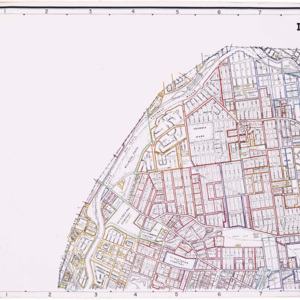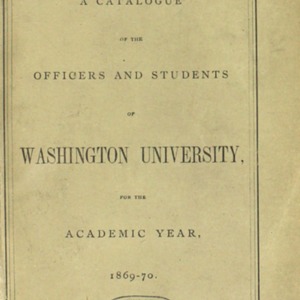Browse Exhibits (70 total)
The State of the Union: Reconstructing a Thomas Jefferson Family Library
In 1880, a gift of about 3000 volumes was given to Washington University from the library of Joseph Coolidge. In 2010 it was discovered that at least 82 volumes of this collection had once belonged to the nation's third president, Thomas Jefferson. Washington University is now the third-largest holder of Jefferson’s books, after the Library of Congress and the University of Virginia. With this 2012 exhibition and the expanded online version of it, we are pleased to privde additional details about the make up of the collection - patterns of ownership and use, distribution of subjects and languages, etc. - and to report on Washington University's ongoing stewardship activities.
Thrill Seekers
Thrill Seekers features the artwork of mid-century men's magazines. Navigate through the exhibit using the links on the right, starting with the introduction.
Urban Books
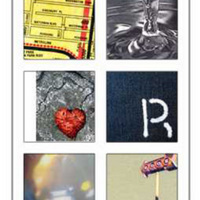
This site documents the Urban Books Collection of artists’ books in the Olin Library Special Collections
at Washington University.
The site is intended as a study resource for students in the Urban Books course, an interdisciplinary project combining urban theory, graphic design, and the production of artists’ books originally created and taught by Jana Harper and Zeuler R. Lima (until 2013) and currently taught by Zeuler R. Lima and Ken Botnick (since 2014).
The original collection of 91 books was purchased in 2004 at Printed Matter bookstore with support from an Interdisciplinary Teaching Grant from Washington University received by the original faculty team.
The goal of assembling this collection has been to provide study material for students in the class, which has has been taught since 2004. Since then, student final projects have been added to the collection, which now numbers over 150 books.
Viktor Hamburger
This page was created to support a library exhibit of medals, reprints, photographs, etc., during October, 2000. Although those materials are no longer displayed together in the library, this will be maintained as a virtual exhibit.
There is a small permanent display of some honors, photographs and other memorabilia located on the south side of the Life Sciences Building, Level 2, on Washington University in St. Louis Danforth Campus.
A portrait of Viktor Hamburger hangs in the 2nd floor hallway between Rebstock Hall and the Life Sciences Building on the Washington University Danforth Campus.
Washington University Papyri Collection
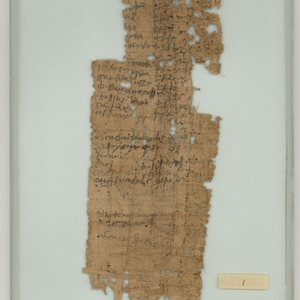
The Julian Edison Department of Special Collections in Olin Library houses 445 manuscript fragments, dating from the first century BCE to the eighth century CE. The fragments were excavated in 1922 Sir William Flinders Petrie and the Egypt Exploration Society at the site of the ancient Egyptian city of Oxyrhynchus.
The papyri collection is the property of the Washington University Department of Classics. Permission to access the collection and to publish any of its contents must first be procured from the Department.
The content in this digital exhibit represent the fragments that were published in two volumes: Washington University Papyri I : Non-literary Texts (1980) and Papyri from the Washington University Collection, St. Louis, Missouri. Part II (1990), both available at Olin Library and in Special Collections.
Imaging and cataloging sponsored through Advanced Papyrological Information Ssystem III, a National Endowment for the Humanities funded project, in 2003.
William H. Gass: The Soul Inside the Sentence
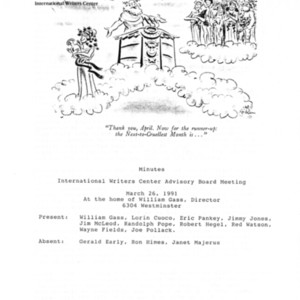
Welcome to the digital companion to the "William H. Gass: The Soul Inside the Sentence" exhibition in Olin Library, March - July 2013, examining the life and work of William H. Gass, an esteemed American novelist, short story writer, essayist, critic, photographer and former philosophy professor.
Explore drafts of published and unpublished writings, recordings of his interviews and readings, photographs and scans of important documents and objects that have shaped his life. You will also find an essay, "My Memories of the Service," which Gass wrote specifically for this digital exhibit.
Click here find out more about William H. Gass and his literary papers at Washington University Libraries Special Collections.
Use the "Contact Us" link at the bottom of each page to reach Joel Minor, the curator of the Modern Literature Collection, if you have questions, requests, rights concerns, etc.
To navigate the digital exhibit, click on the category you wish to see, then one of the subcategories that will appear below the main categories. Select an item below the subcategories to see its metadata and to view it up close. Click on the banner to return to the main page.
World War I and its Effects on Expressionist Aesthetic Direction
At the turn of the twentieth century, there was an influx of artists rejecting the traditional academic standards, a process that started out with the Impressionists in the late 19th century. These artists focused more on depicting the inner essence of their subjects, rather than merely realistically describing their appearance. They also had an interest in non-Western cultures, appropriating their visual language into their primitivist paintings, sculptures, and woodcuts. In France, the Fauves were the most well known of these artists, whereas in Germany, these artists were collectively labeled the Expressionists.
In 1914, World War I broke out. Many artists during that time were drafted into their respective country’s militaries. Some of them would find their end in combat; for the ones that survived the war, their worldview would be changed irreversibly as a result, along with the way they portray those worldviews through their work.
In this exhibition, we take a look at three of the artists who had experienced the outbreak of World War I, and lived through it to tell their personal tale through the art they made during and after the war. We start with Beckmann, tracing his radical shift in towards a more esoteric subject matter and caricature-like visual style to the trauma he experienced while as a medical orderly. Originally a proponent of the upcoming war, the despair of seeing the dead and wounded lie around him suffocated Beckmann mentally, resulting in his mental breakdown and subsequent discharge from the military. This results in his deformed, claustrophobic compositions in his later works such as The Dream.
After looking at Beckmann, we then turn our attention to the other side of the conflict in World War I—the French artist André Derain. Having also experienced war like Beckmann, how did being among the victorious French instead of one of the defeated Germans affect him differently? Previously known for his wild colors and simplified forms since 1905, did the war cause him to sober up in his aesthetics as seen in his Guitarist, or was the process already underway by the time the war broke out? The answers to these questions will be discussed and revealed.
Lastly, we look at Pechstein, whose tale of expulsion from his personal paradise, though a direct result of the war, affected him more than his participation in the war itself. In his Bay of Monterosso we can experience the same nostalgia he had for his time at Palau, albeit through a different subject matter. Like many other Expressionists, Pechstein believed that non-Western cultures like the Palauans lacked civility, resulting in them being closer in touch with nature. This is in contrast to the perceived social corruption fueled by consumerism that was happening in the European cities before the war. Having been painted during the war instead of after, Bay of Monterosso also highlights the thought processes Pechstein had in the middle of the war, as compared to an indirect reminiscing after the war has passed. From this we can also see Pechstein’s optimism for a better future for Europe amid the chaos that surrounded him at that time.
From a study of these three artists and their works, it can be seen that there is no one template that fits anyone; each artist has their own takeaway from their unique experiences during the war period. It is my hope that you would also have your own takeaway after viewing this exhibition.
You Can Judge a Book By Its Cover
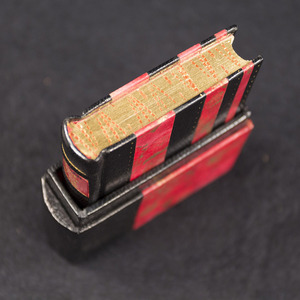
You Can Judge a Book by its Cover: 33 MINIATURE DESIGNER BINDINGS
This exhibition celebrates the variety and beauty of the art of book binding with 33 different interpretations of the same book by a group of distinguished and talented book binders. Mel Kavin, a publisher and collector with a keen interest in bookbinding, commissioned designer binder and author, Bernard Middleton, to write the text of You Can Judge a Book By Its Cover, with the goal to produce a miniature book. The first book was designed by Ward Ritchie, with a book binding designed by Tini & Einen Miura, and printed by Henry Morris. Kavin went on to commission other world-class binders to design and create a binding of the Middleton text, and said he eventually stopped at 33 books, for no good reason “but that I had to stop somewhere.” Together these 33 books highlight a wide spectrum of celebrated 20th century book binding artists and the artistry of the miniature book.

